skip to main |
skip to sidebar
Events of Sunday, 24th April 2016
The sea remained calm overnight as we lay at anchor off Ba Wel Island, so I slept fairly well in the unfamiliar surroundings, We enjoyed an excellent European-style cooked breakfast in the dining area on the open aft deck, as the nearby fishing vessels set off for the day. I was amused by the sight of a powered vessel, with the customary Chinese-made, noisy, single-cylinder diesel engine driving a 'long tail' propellor, towing a number of small boats each with one man taking his ease as they moved to the fishing ground. The deck of the larger boat carried three more small boats. Presumably, when they reached a suitable location, all the small boats would fish independently, positioning themselves using the pair of T-handled oars each boat carried.
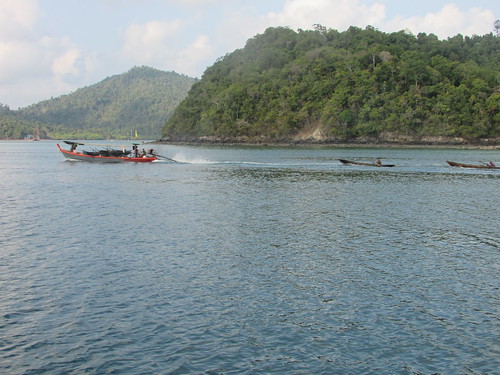 Powered fishing boat leaving Ba Wel Island, towing small boats.
Powered fishing boat leaving Ba Wel Island, towing small boats.
The islands in this area are the home of the remaining 'Moken Sea Gypsies' who do not use fishing nets. Originally, the men practiced spear-fishing from small boats whilst women would dive for sea urchins. Our ship sailed to one of the islands where the simple life style of the 'Sea Gypsies' survives - Nyaung Wee Island, south of Lampi Island.
We approached Naung Wee, a heavily-wooded, hilly island from the east. As we came nearer, we could see a village of simple buildings straggling along a narrow, white sand shore. Behind the village, a steep path led diagonally up the hillside to a small, golden pagoda.
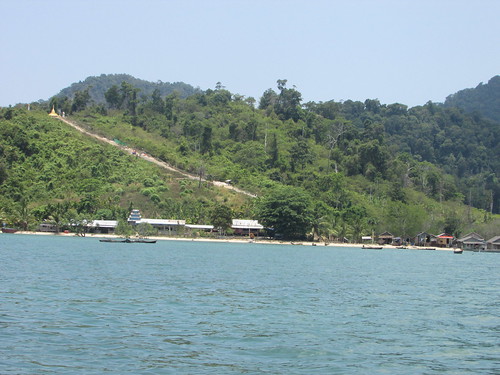 Nyaung Wee Island, Mergui Archipelago.
Nyaung Wee Island, Mergui Archipelago.
We anchored in the bay among a variety of vessels and our dinghy was brought alongside to take the guests ashore. As we clambered onto the narrow beach, we were quickly joined by the young local children who took their visitors by the hand and conducted us along the single village 'street'.
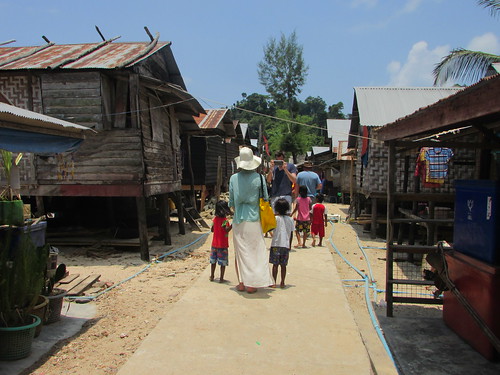 Being conducted through the village by the young local children.
Being conducted through the village by the young local children.
It may not have been entirely coincidental that we ended up at the village shop where our Burma Boating guide arranged some simple treats for the young people.
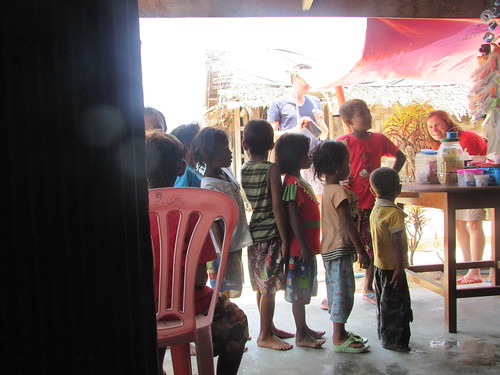 Nyaung Wee Island: At the village shop.
Nyaung Wee Island: At the village shop.
The neat pedestrian street ran parallel to the shore, in between two rows of wooden-framed buildings, lifted a few feet off the ground. Walls were either woven bamboo, wooden planks or galvanised iron and roofs were clad with galvanised iron sheets or, in a few cases, thatch. Each building had a mains water supply, provided from a system of blue HDPE distribution pipes with plastic isolating cocks which was simply laid in the sand on either side of the walkway. At least one beach-side property sported a satellite dish. One house was being re-built, revealing the no doubt effective but rather crude building techniques adopted.
 Nyaung Wee Island: Rebuilding a house.
Nyaung Wee Island: Rebuilding a house.
We passed the Government primary school (closed, as our visit was in the holiday period as well as on a Sunday) and returned to our waiting dinghy. The bay had numerous moored small boats, of various sizes, testifying to the importance of the sea to the villagers. A few boats had the familiar diesel engine with 'long-tail' propellor but most were wooden dug-outs with the characteristic T-handled oars.
 Nyaung Wee Island, Mergui Archipelago.
Nyaung Wee Island, Mergui Archipelago.
I felt rather wistful as 'Meta IV' left the island and its interesting community but lunch was available and we'd been promised a visit later to a beach on an uninhabited island called variously Clara Island or, more prosaically, island 115.
This trip ashore was definitely for pleasure, allowing swimming and snorkelling from the white sand beach.
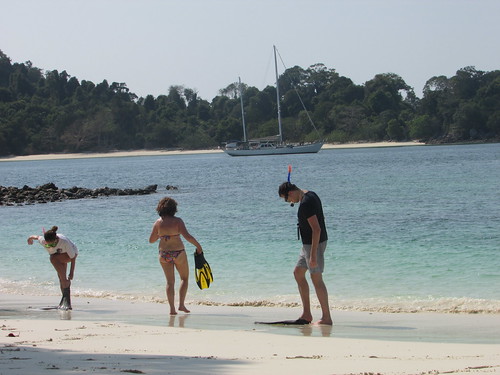 Clara Island beach visit, with 'Meta IV' in the background.
Clara Island beach visit, with 'Meta IV' in the background.
Following some problems with my knees made worse by the exertions of my trip earlier in the year (described here), I again declined the temptations of swimming in the delightfully warm water but the dinghy had also towed a moulded plastic 2-person kayak to the beach for those interested. I eventually decided to take out the kayak and, after initial difficulty launching from the soft sand, had a marvellous interlude slowly paddling around the bay.
 Clara Island beach visit: The kayak patiently awaits its next user.
Clara Island beach visit: The kayak patiently awaits its next user.
Our dinghy returned the guests to 'Meta IV' for relaxation prior to the evening meal. Meanwhile, the ship was positioned to a suitable overnight anchorage off Nyaung Wee. As the previous night at Ba Wel, we soon found ourselves in the company of a number of fishing vessels also anchoring for the night. They maintained what might be thought a 'respectful' distance but I found their presence rather comforting. I'm afraid that once the evening meal was finished, I was finding myself quite ready for bed so I didn't delay long before retiring.
Related posts
My report on the following day aboard 'Meta IV' can be found here.
All my posts on my trip to Myanmar in 2016 can be found here.
My pictures
Pictures in this article can be viewed uncropped by clicking on the image. To view in other resolutions or download, select from the albums below:-
Nyaung Wee Island, Mergui Archipelago.
Beach visit (115).
All my pictures taken on my trip to Burma in 2016 are in the collection Burma, 2016.
I wanted to see a little of the far south of Myanmar in the Tanintharyi Region which forms the northernmost part of the Malay Peninsula. Here, the land mass is only around 45 miles wide and this is shared by Myanmar, with its coast facing west on the Andaman Sea, and Thailand, with its coast facing east on the Thai Gulf.
Since this part of Myanmar is largely noted for its 800-odd offshore islands forming the Mergui Archipelago (also called the Myeik Archipelago), I'd decided to take one of the Burma Boating Cruises on a small sailing ship embarking in Kawthaung.
Events of Saturday, 23rd April 2016
Flying is by far the fastest way of travelling from Yangon to Kawthaung so on Saturday, 23rd April 2016 I travelled on an Apex Airlines ATR-42 turbo-prop XY-AJV from Yangon with one intermediate stop at Dawei.
 On arrival at Kawthaung, luggage is unloaded as an elderly fuel bowser re-fuels the aircraft.
On arrival at Kawthaung, luggage is unloaded as an elderly fuel bowser re-fuels the aircraft.
On arrival, I was met by the Burma Boating chief guide, Aung Kyaw Kyaw, and introduced to two fellow-passengers. We were driven into Kawthaung and disembarked at Myoma Jetty, near the centre of the bustling town where we were joined by two more passengers. We were told that the final two passengers were arriving from Ranong Airport in Thailand.
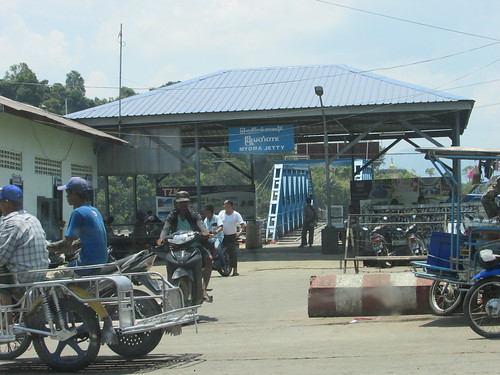 Myoma Jetty, Kawthaung.
Myoma Jetty, Kawthaung.
We made our way across the jetty to the floating steel pontoon against which a number of large launches were moored. Half-hidden in a corner was a rigid, inflatable dinghy which was to take us to our vessel. Clambering off the steel pontoon into the dinghy was safely accomplished and we set off across the harbour to an elegant sailing vessel, the 'Meta IV' and our home for the next six days.
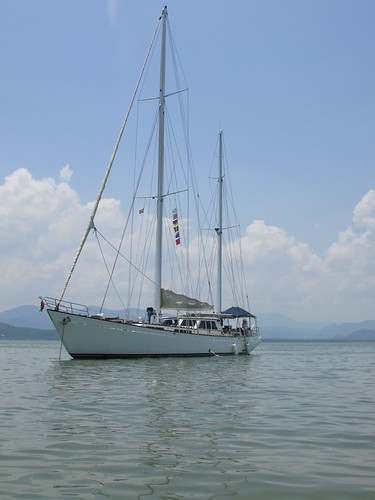
My home for six days - 'Meta IV'.
A few statistics of the 'Meta IV'
Length: 23.75 m
Breadth: 5.7 m
Draught: 2.85 m
Net tonnage: 35
Gross tonnage: 58
Fitted with a 195 kW Cummins diesel and single, reversible screw.
She was built 1998 in Phuket, Thailand and there are some interesting pictures of her construction and early trials in the album Sailing Vessel 'Meta IV'. Although built and originally rigged as a 2-masted ketch, the sail has been removed from the aft ('mizzen') mast so she now has a headsail and mainsail. Most of our cruising was performed using the diesel engine but, on two days, the crew ran under sail part of the time, easily making 8 knots.
To accommodate up to 8 passengers and 4 crew, together with auxiliary engine, fuel, fresh water and effluent tanks, within the complex contours of the sailing hull requires some ingenuity but the result, if not spacious, was practical, including a shower cubicle with vacuum-flush toilet for each cabin.
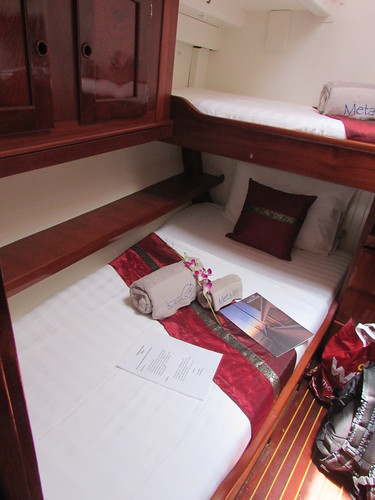
Sailing Vessel 'Meta IV': My cabin.
My cabin had a lower bunk set fore-and-aft, which I used, and an upper bunk athwartship.
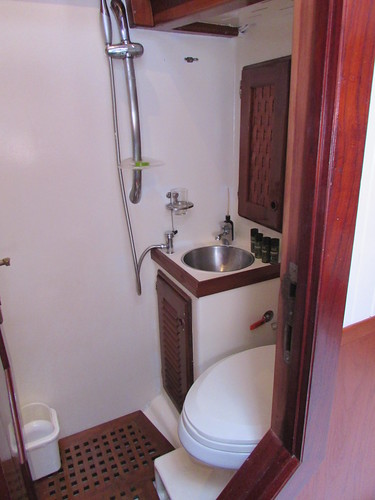
En-suite Vacuum W.C., Wash handbasin and Shower.
Sailing to Ba Wel Island
Once our final passengers, a young couple, were on board, the anchor was raised and we headed out to sea using the diesel engine, passing one anchored cargo vessel, the 'Shwe Tharaphu' and numerous fishing vessels of various sizes and designs.
 Kawthaung and its fishing fleet viewed from 'Meta IV' en route to Ba Wel Island.
Kawthaung and its fishing fleet viewed from 'Meta IV' en route to Ba Wel Island.
The mainland falling behind us was dotted with golden pagodas, as were some of the islands we were passing. At one point, I saw a strange construction rising out of the sea - a fence of vertical bamboo poles covered in netting which I presumed was a 'fish trap'. Our inflatable dinghy was simply towed behind us, on a long line. We were flying a rather faded Austrian flag at the stern, as 'Meta IV' was registered in Salzburg, Austria.
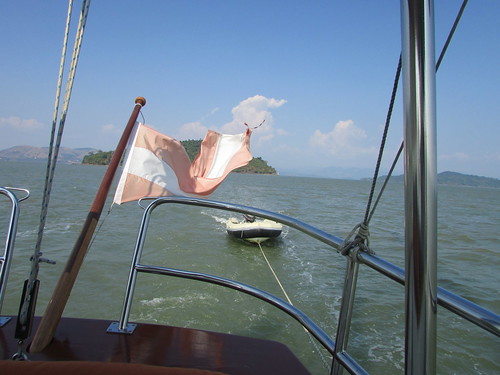 Aboard Sailing Vessel 'Meta IV' to Ba Wel Island.
Aboard Sailing Vessel 'Meta IV' to Ba Wel Island.
With guests assembled in the dining area on the aft deck, our guide gave us a briefing on our itinerary for the next few days which would take us to various locations around Lampi Marine National Park.

Map of Lampi Marine National Park.
Click here for a larger view.
I spotted Myanmar Navy vessel 558. There's an interesting Wikipedia article on the Myanmar Navy from which I learned that 558 is a 5-series Fast Attack Craft built by the Myanmar Naval Dockyard in 2004 armed with both guns and missiles.
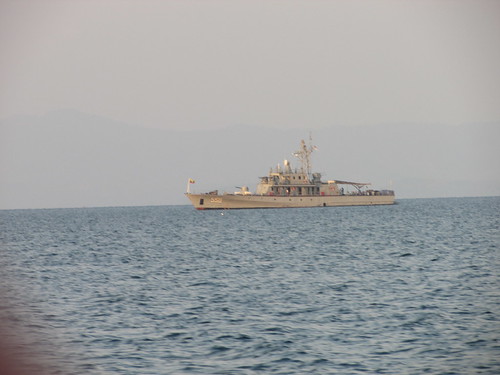 Fast Attack Craft 558.
Fast Attack Craft 558.
It was late afternoon when we anchored off Ba Wel Island and celebratory champagne was served to the guests.
 Arrival off Ba Wel Island.
Arrival off Ba Wel Island.
Our first visit ashore on Ba Wel Island
Our trailing dinghy was hauled alongside on the port side and the guests prepared for the first of many disembarcations in order to be ferried to a nearby deserted white sand beach. Whilst the other guests enjoyed a cooling swim in the tranquil water, I contented myself with beachcombing. All the time, fishing vessels were anchoring offshore apparently for the night, some in companiable groups side-by-side, some individually. We then returned to 'Meta IV' for a splendid dinner prepared by our Thai lady cook before retiring for our first night afloat.
Related posts
A report on the following day on 'Meta IV' is here.
All my posts on my trip to Myanmar in 2016 can be found here.
My pictures
Pictures in this article can be viewed uncropped by clicking on the image. To view in other resolutions or download, select from the albums below:-
Yangon - Dawei - Kawthaung by air.
Around Kawthaung.
Sailing Vessel 'Meta IV'.
Sailing from Kawthaung to Ba Wel Island.
All my pictures taken on my trip to Burma in 2016 are in the collection Burma, 2016.
[Minor corrections: 8-Jul-2016]
On Wednesday, 4th May 2016 I travelled on the 7.00 a.m. train from Thazi to Kalaw. The first four hours of the journey, including the first 'Zig-Zag' are described here. Now read on ...
As we continued towards Kalaw from the upper junction of Zit Zat Reverse (A), I looked back along the train and saw the 'downhill direction' fixed distant signal for the upper junction, with its arm extended the 'wrong' way.
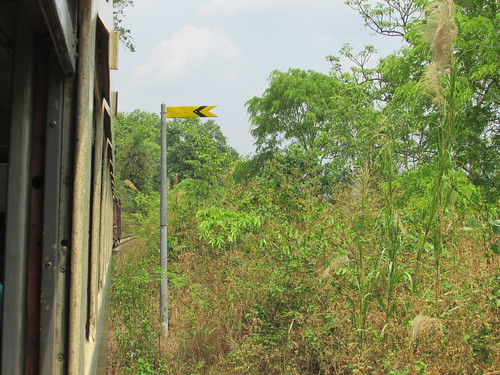 'Downhill direction' fixed distant signal for the 'Zit Zat' upper junction, with its arm extended the 'wrong' way.
'Downhill direction' fixed distant signal for the 'Zit Zat' upper junction, with its arm extended the 'wrong' way.
We passed a series of ungated, minor road crossings. Approaching each crossing, the driver sounded the locomotive horn. The train passed another village of bamboo houses. The back yards of these houses had enclosing fences close to the railway with a back gate opening onto the track. I noticed one house with an gateway covered in masses of beautiful pink flowers but with no actual gate.
The meals served at stalls on stations or by vendors travelling on the train are served in expanded polystyrene boxes. I'm afraid that, in general, the Myanmar people have no concept of 'litter' so, once the food is consumed, the plastic box is flung from the open window of the train. For some reason, it appeared that certain lengths of trackside passing through shallow cuttings seemed to be unattractively festooned with lots of cast-off boxes. I didn't notice the same concentrations of boxes when views across the mountains were available.
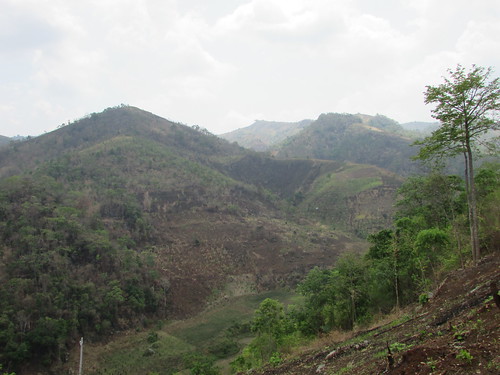 View of mountains as we approach Hkway Yok.
View of mountains as we approach Hkway Yok.
Twenty minutes after leaving the first Zig-Zag we passed a home signal (maintained at danger) and stopped at the second Zig-Zag station, named Hkwye Yok. The facilities were similar to those at the previous Zig-Zag station (but without the 'scissors' crossover). The line from Kalaw converged on our right at a turnout, then re-divided into a platform line on our left (which my train took) and a parallel siding. There was a similar proliferation of signals and an elevated ground frame beyond the end of the platform. As we slowly pulled down the platform, a growling on the right alerted me to a descending train waiting in the parallel siding - a unidentified Bo-Bo-Bo in red white and blue livery at the head of a train of empty, air-braked bogie ballast hoppers.

Hkway Yok Zig-Zag Lower Station, with an empty ballast train waiting to descend.
A row of food stalls lined the platform and ladies selling fruit, balanced on metal trays carried on the head, patrolled the length of the platform.
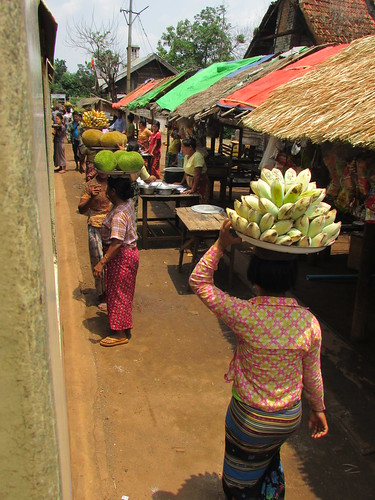
Hkway Yok station platform.
A loud 'clank' from the opposite side of the train indicated that the ballast train was restarting its descent. After a few minutes, the points had been reset and we continued our ascent, with our locomotive propelling from the rear as far as the upper junction of the zig-zag.
As we left the station, I had a better view of the elevated ground frame, an 8 lever-frame, suitable for signal box use with a conventional horizontal locking tray, but with the building omitted. Instead, a small steel platform provided with a handrail had been erected with a length of signal ladder to allow access from the ground. I was amused to note that the steel platform appeared to be second-hand pierced steel planking. Levers 1 to 6 were painted red, with the first four in the normal position, the other two reverse. Lever 7 was spare, painted white, and lever 8 was yellow. All levers except the spare were fitted with 'Trapped Key' locking boxes (there's a little more information about 'Trapped Key' locking here). Levers 1,2,5 and 6 had signal wires attached (although all the movements I saw were signalled by flag). There was no connection to the frame for point operation although one run of tubular rodding half-buried in the sand suggested that this had once been provided.

The elevated ground frame at Hkway Yok Station.
Our locomotive, working hard, propelled the train up the gradient and over the points at the upper junction, where there was an elevated ground frame as at the other zig-zag junctions, this one with an adjacent substantial hut for the operator. Frame and hut were located at the edge of a fairly precipitous drop. The ground frame was 6-lever with the usual horizontal locking tray. Some of the levers were provided with 'Trapped Key' locking boxes. Levers 1 and 2 were red, with signal wires leading away. Lever 3 was yellow, now disconnected from the cranks and tubular point rodding which once operated the single set of points. Levers 4 and 5 were also red but I only spotted a signal wire from lever 5. Lever 6, although red, was spare.
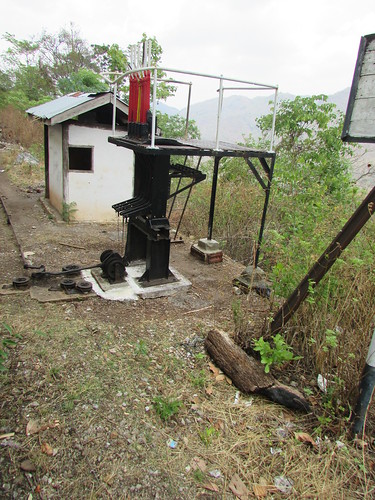
Hkway Yok Upper Zig-Zag Junction Elevated Ground Frame.
A longyi-clad pointsman, who had apparently travelled with us from Hkway Yok Station, dropped off the diesel as the train passed the points and came to a stand in the siding. Very soon, the pointsman had removed the point clip, operated the points, re-clipped them and signalled us away on our journey to Kalaw with the usual grubby green flag. The junction points themselves were provided with the usual, battered, point indicator.
 Departing Hkway Yok Upper Zig-Zag Junction, watched by the Pointsman.
Departing Hkway Yok Upper Zig-Zag Junction, watched by the Pointsman.
Whilst we waited, I noticed a semaphore signal behind our train. This was presumably for the benefit of descending trains where the locomotive would have stopped well down the siding to ensure the rear of the train had cleared the points. The signal presumably indicated when the locomotive could start to propel the train down the gradient to Hkway Yok Station. In addition to this signal, there was a home for the line from Hkway Yok Station (although I didn't spot one for trains approaching from Kalaw). There were certainly starting signals for both directions. Most of the signals had short, wooden posts, all had short corrugated arms arranged as upper quadrants but with a heavy, cast spectacle which looked designed for lower quadrant. The arm of the starting signal towards Kalaw was virtually centre-pivoted and the arm projected to the right of the post, with the spectacle on the left, so it looked very curious indeed. As expected, none of the interesting signals was operated for us, although all were quite neatly painted.
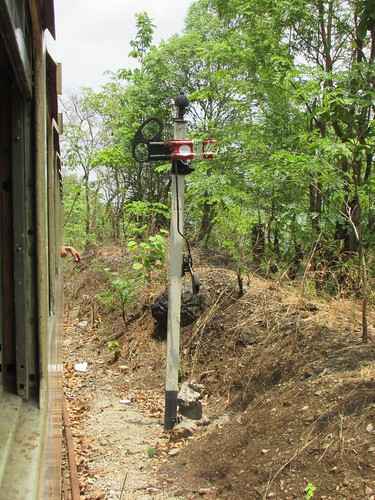
The curious starting signal towards Kalaw at Hkway Yok Upper Zig-Zag Junction.
We passed a fixed distant and the driver sounded the horn as we approached an ungated road crossing. We were treated to impressive vistas across the mountains are we continued our journey. We passed another short, corrugated arm signal with a cast lower-quadrant style spectacle this time, for variety, arranged for lower-quadrant operation but it was no surprise to be called on by a flagsignalman with a green flag. We paused at an attractive country station which I took to be Hsin Taung. A broad valley had opened on our right with a golden standing Buddha and monastic buildings visible. There was no passing loop at the station but a branch on our left as we left the station appeared to have a loop. The 'downhill' home signal had a short, corrugated arm, lower-quadrant style spectacle but arranged for upper-quadrant operation. The signal post was U-channel rolled-section. I also glimpsed a tall 'Outer Home' signal.
We were now engaged in a stiff climb over a curving route. Although I knew we were climbing, it was still a surprise to look out on the right and see the line we'd travelled about ten minutes before at right angles to our present heading and considerably lower.
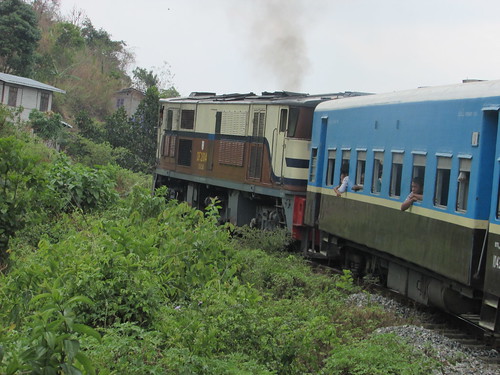 "We were now engaged in a stiff climb over a curving route".
"We were now engaged in a stiff climb over a curving route".
Once again, our route was on a 'shelf' cut into the mountain side and retaining walls were needed. Earlier ones were brick, more recent ones concrete with embedded plastic drainage tubes. Some walls featured a concrete plaque commemorating the completion date. One I noticed was '21-1-2016'. We passed through a noisy, reverberating tunnel, concrete-lined followed by more retaining walls with various dates in different styles.

Emerging from the first tunnel.
We passed through a second, short tunnel and whistled for a road crossing before a period where our speed became fairly erratic but I couldn't determine whether this was because of engineering speed restrictions or the line profile. Our route was now through paddy-filled upland. A tall Outer Home signal (unusually, in the 'off' position) indicated that we were approaching Myin Daik. Here, the leftmost track with platform and station buildings was occupied by waiting DF.2010 with a 'downhill' train. We took the loop to the right. As we stopped, I saw yellow-liveried Engineering Maintenance Car EMC.D.2 in the loop on our right.
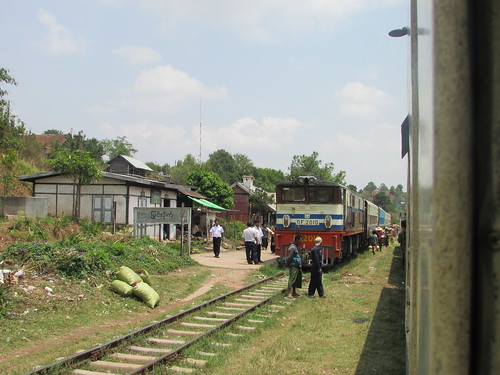 Myin Daik Station.
Myin Daik Station.
The 'downhill' train left before us, then we were off on the final eight miles to Kalaw, passing through paddies where people were working as they have done for centuries.
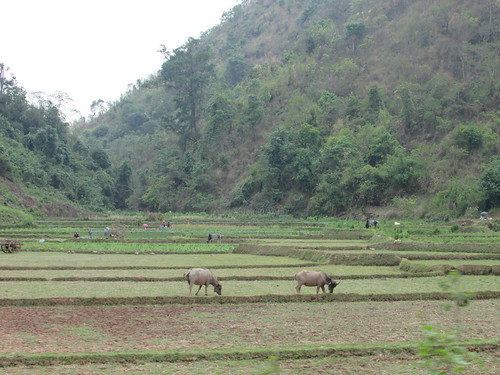 Working in the paddy fields.
Working in the paddy fields.
As we approached Kalaw, the area became more built-up. On the left, next to the railway, I spotted The Kalaw Hotel (now the Kalaw Heritage Hotel), opened by the British in 1902 then we rumbled over a road crossing and came to a halt. Another train, also hauled by a Bo-Bo-Bo, was shunting on the leftmost platform line so, again, we stopped in the loop to the right. In a siding on our right, I saw Railway Gang Car RGC/6 before struggling to the ground with my luggage. My guide, Sai Kyaw Kyaw, was waiting and instantly recognised me as the only unaccompanied elderly female tourist to disembark (I think the only tourist to disembark from the train). Kalaw has a distinctive 'Swiss Chalet' design station building so, after a few photographs, my guide took me to my accommodation after a tiring, but fascinating, journey from Thazi.
 Kalaw Station Building.
Kalaw Station Building.
Related posts in my blog
Thazi-Kalaw.
Thazi Railway Station and Diesel Locomotive Depot.
All my Myanma Railways posts.
My Pictures
Pictures in this article can be viewed uncropped by clicking on the image. To view in other resolutions or download, select from the album Thazi to Kalaw by Train.
There are also a few pictures taken around Kalaw station on 5th May 2016 here.
All my Myanma Railways Pictures.
On Wednesday, 4th May 2016 I travelled on the 7.00 a.m. train from Thazi to Kalaw. Having identified my reserved Upper Class Seat, there was time to look at the locomotive, Alsthom-built DF.2014 re-powered with a CAT 3515 engine, before boarding the train.
 DF.2014 at the head of the 7.00 a.m. departure from Thazi.
DF.2014 at the head of the 7.00 a.m. departure from Thazi.
The train had two Upper Class Coaches in cream and brown sandwiched between 2 Ordinary Class coaches in blue and brown. Two bauxite-coloured bogie vans were at the rear. The train had vacuum brakes, supplemented by 'straight air' brakes on the locomotive.
To my amazement, the train departed dead on time. Just south of the station we crossed Thazi's dual-carriageway 'main street' on a level crossing which, unusually, had full gates rather than the usual 'half barriers'. Here, there were three running lines - our single line to Kalaw, Up Mandalay and Down Mandalay.
 Thazi Level Crossing, looking east.
Thazi Level Crossing, looking east.
After a few hundred yards, our line turned eastwards across the plain, and we passed a series of minor level crossings, each with its flagman.
 Passing a minor level crossing and approaching an outer home signal showing 'clear'.
Passing a minor level crossing and approaching an outer home signal showing 'clear'.
We made our first stop at the small station of Hlaingoet, the next at the larger station at Payangazu.
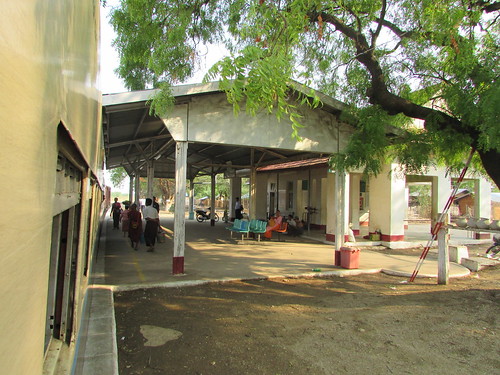 Payangazu station.
Payangazu station.
A flagman warned us across 2-span bridge number 48. Through the heat haze, the grey silhouette of the mountains was visible and loomed larger as we continued our climb. I noticed that the tops of the mountains were fringed with trees and it made me think of stubble on on an unshaved man's chin. We passed another level crossing at road marker 'km49'. Bridge 55 was traversed near a screeching reverse curve. The line twisted and turned through cuttings hewn in rock, with the loco working hard. We slowed to observe a 5 m.p.h. restriction over a tall, curving multi-span river bridge.

Crossing the tall, multi-span river bridge.
The track continued to curve to the right and were still going very slowly as we passed a large stock of concrete sleepers, apparently thrown trackside from a train ready for relaying. Looking down, I could see the tall, multi-span river bridge below us we'd just crossed. In less than five minutes, as the train climbed, we'd also turned 180 degrees.
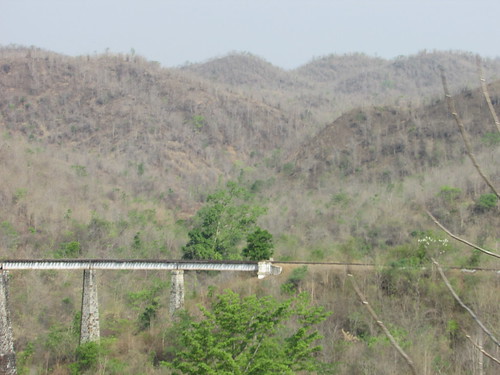 Looking down on the multi-span bridge with mountain tops fringed with trees in the background.
Looking down on the multi-span bridge with mountain tops fringed with trees in the background.
Before the railway came, this must have been fairly impenetrable forest. Our Bo-Bo-Bo locomotive was still working hard on the front of the train as we entered another cutting, whistled for a short tunnel and emerged into another cutting.
The cutting opened out on an elevated plateau with a large village. Most of the buildings were bamboo framed with woven walls but some also sported satellite dishes. There were numerous ungated crossings, some no wider than passageways. After a broader, gated road crossing we stopped at Yin Mabin station with the usual loops, one stabling a Railway Gang Car (RGC.008). Our train had stopped adjacent to an abandoned water column which, back in the days of steam, must have been a great consolation to trains struggling up the fierce gradients. Two track workers dumped their tools in the end of my coach and squatted in the vestibule as we set off.
 Track workers loading their tools at Yin Mabin.
Track workers loading their tools at Yin Mabin.
The modest station buildings had the usual ceremonial flagpole on the platform. There was also a remarkably neat stall supplying meals, nowadays supplied in the dreadful expanded polystyrene boxes. Alternately, similar food could be purchased from the various vendors who walked through the train, together with fresh fruit, bottled water bottled soft drinks and even ice lollies (from a cool box).
Yin Mabin (together with a number of other stations on the line) featured the same type of horizontal windlass I'd seen on the line to Pyin Oo Lwin. They appear to operate signal wires and I assume that they once operated home signals, allowing only one signal to be cleared at a time.
 Yin Mabin station. Note the horizontal windlass set on a circular platform on the right.
Yin Mabin station. Note the horizontal windlass set on a circular platform on the right.
Leaving Yin Mabin the terrain became fairly open as we passed over a 3-span plate truss bridge (number 104) set on stone piers and abutments. Bridge 105 was of similar construction. We passed one of the individualistic fixed distant signals - on this example, the arm extended to the right of the post! We pass a home signal with the odd-looking 'lower quadrant arm arranged for upper quadrant'.
We passed through Pyi Nyaung, provided with a platform line and two loops, without stopping. The line passed over an elderly lattice girder bridge which had been left in place but with its load taken over by modern through girders. After passing slowly through another cutting, we slowed again to pass over over a bridge where the two track workers who'd joined the train at Yin Mabin jumped down with their tools, joining a group of workers already there working to renew wooden sleepers over the bridge. I noticed I'd been travelling for two and a half hours hours.
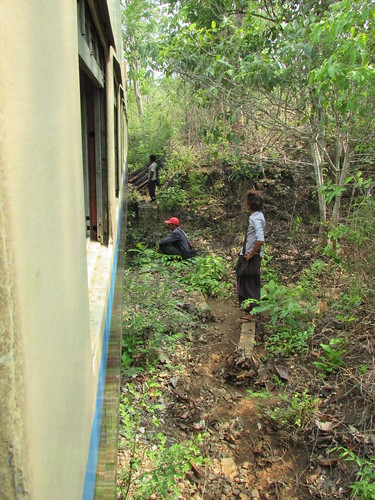
Track workers adjacent to a bridge where wooden sleepers are being renewed.
The driver then applied power as we struggled in and out of curving rock and shale cuttings high above a broad valley and passed through forests of bamboo.
In places, I saw the remains of a former railway telephone wire route which appeared to have once carried just two wires. The railway now seems to rely on a collection of fairly old technology radio systems for its communications and tall bamboo masts supporting an antenna can be seen at most stations. I noticed bridge number 167 before we passed over a level crossing equipped, unusually, with a continuously-sounding warning horn.
Smoking is now prohibited on Myanma Railways. From time to time, a smoker would pass through the coach to take a quiet smoke in the vestibule. Since the doors on these coaches are normally left open for ventilation and there are often massive openings around gangway connections, other passengers are not inconvenienced by this practice.
The train twisted and turned, running along a narrow 'shelf' cut into the contours the hills with a broad valley on one side and a rock and shale wall, with numerous trees relying on a precarious root-hold, on the other. The train didn't stop at Ye Bu but some two miles further on we paused at Le Byin where there is a platform line and three loops. A Carriage and Wagon Examiner appeared and walked down the train 'wheel-tapping' - a once-common sight in Britain. The sound of a tinkling bell told that an ice-lolly vendor was also working his was down the train. An indication of the elevation was given by the fact that the small, corrugated iron roofed station building was provided with a chimney for an internal fireplace. Everything around the station appeared neatly painted in black and white. Even the mast for the radio antenna was painted in black and white bands.
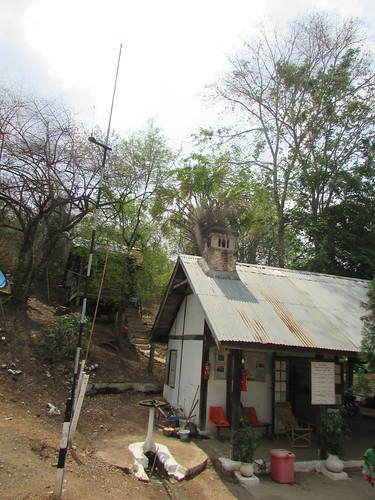
Le Byin station.
We departed at 10.20 a.m., passing another abandoned water column and a raft of loaded bogie ballast wagons parked in one of the loops. The points were operated by ordinary hand levers. After passing over a minor level crossing closed by hinging bamboo poles, we passed a group of pigs happily foraging along the trackside. I was intrigued by Le Byin's 'downhill' home signal - an attractive lattice post and finial with a corrugated steel upper quadrant arm (just an arm, not even a 'vestigial' spectacle). Mounted on the post was a mechanical 'slot', allowing control of the signal from two locations (there's a short description of 'slotting' here).
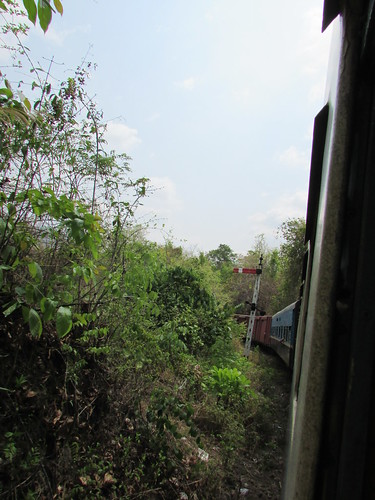
Le Byin's 'downhill' home signal with a mechanical 'slot'.
In the next 20 minutes, we passed a group of farmers restraining their oxen as the train passed, rock cuttings, glimpsed a large village in the valley on our left and came to the first 'Zig-Zag' where the line from Kalaw converged on our right at a scissors crossover. Beyond the scissors, there were two parallel tracks with a disused water column between them. We look the left line which was provided with a platform, station buildings and the standard wooden station nameboard solemnly labelled ZIT ZAT REVERSE (A). Beyond the nameboard, there was an elevated ground frame with red and yellow levers which I didn't get a decent look at. There was a wide assortment of semaphore signals - wooden post, lattice post, full arm, short arm but with corrugated arms and proper 'lower quadrant' style spectacle frames (no glass) arranged for upper quadrant working. As I've found elsewhere, not many signals actually seem to be worked and reliance is placed on handsignals given by flags in various shades of green. The platform was busy with passengers and vendors.
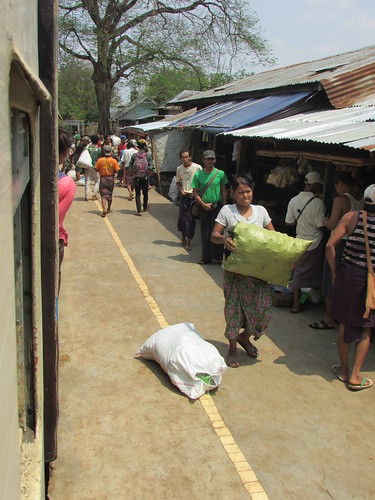
The platform at ZIT ZAT REVERSE (A).
After about seven minutes, during which time a member of the locomotive crew studied coach wheels, perhaps looking for dragging brakes, the points had been reversed and we set off backwards, the locomotive propelling the train which snaked onto the climbing Kalaw line. With the locomotive working hard, within a couple of minutes we were at the top of the Zig-Zag and passing a neat short-arm starting signal for the Kalaw line.
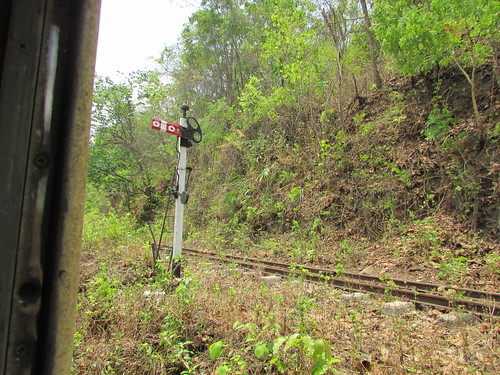 A neat, short-arm starting signal at the top of the first Zig-Zag.
A neat, short-arm starting signal at the top of the first Zig-Zag.
We came to a stand with the locomotive clear of the points which were changed to allow the train to proceed to Kalaw with the locomotive once more at the front of the train. I could see all three sections of the Zig-Zag as we continued out climb.
 The low level and middle levels of the zig-zag viewed from my train on the upper level.
The low level and middle levels of the zig-zag viewed from my train on the upper level.
It was now 11 o'clock and I was four hours into the journey.
The description of the rest of my jorney to Kalaw is here.
History
When the railway was first extended from Taungoo to Mandalay in the late 19th century, Thazi had not established itself. I found a reference only to 'Meiktila Road' (Meiktila is a town 14 miles west of Thazi). An early traveller to Kalaw had to complete the journey from Meiktila Road to Kalaw on horseback. But just as the British, having chosen Pyin Oo Lwin as a suitable Hill Station (and re-named it 'Maymyo' after a British officer), constructed a railway over difficult terrain linking Mandalay and Pyin Oo Lwin, so a similar line was provided from a junction with the Yangon - Mandalay main line over a similarly arduous route to Kalaw and beyond. The main line junction became Thazi and a town grew up around it.
Related posts in my blog
Thazi Railway Station and Diesel Locomotive Depot.
Thazi - Kalaw (part 2).
All my Myanma Railways posts.
My Pictures
Pictures in this article can be viewed uncropped by clicking on the image. To view in other resolutions or download, select from the album Thazi to Kalaw by Train.
All my Myanma Railways Pictures.
Location
Da Nyn Gone is a junction station about twelve miles north of Yangon, where the Circle Line diverges from the line to Pyay. A busy, broad road crosses the railway just north of the platforms. The road is called Khayae Pin Road to the west of the level crossing and Da Nyn Gone Station Road to the east. The station building is on the east side (Circle Line Down platform) and is provided with a small canopy. The island platform (serving the Up Circle Line and the Down Pyay Line) also has umbrella roofing.
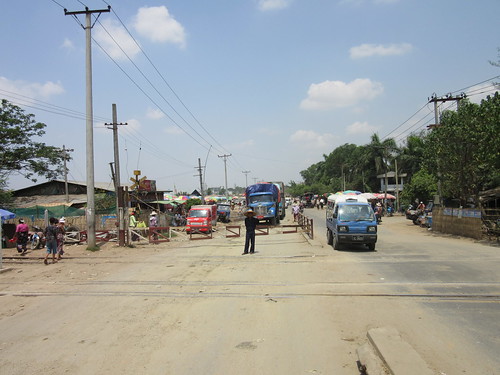 The level crossing at Da Nyn Gone Station, looking west along Khayae Pin Road.
The level crossing at Da Nyn Gone Station, looking west along Khayae Pin Road.
There is a large market a little to the west, which also spills out onto stalls on both sides of the station and numerous vendors on the platforms themselves. In 2014, the whole station area was unfenced, as shown in the view below.
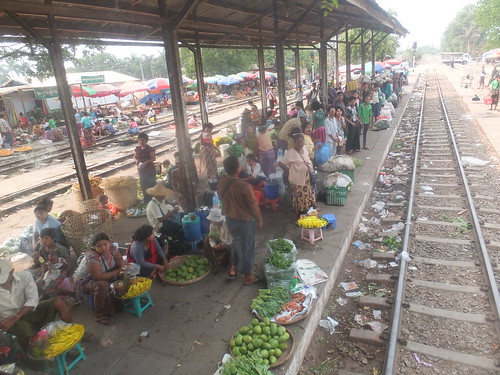 Approaching Da Nyn Gone station with its 'impromptu market', viewed from a clockwise Circle Line Train.
Approaching Da Nyn Gone station with its 'impromptu market', viewed from a clockwise Circle Line Train.
By the time of my visit in 2015, fences had appeared to the west of the station, in between the Up and Down Pyay lines and in between the Up and Down Circle lines, as seen below.
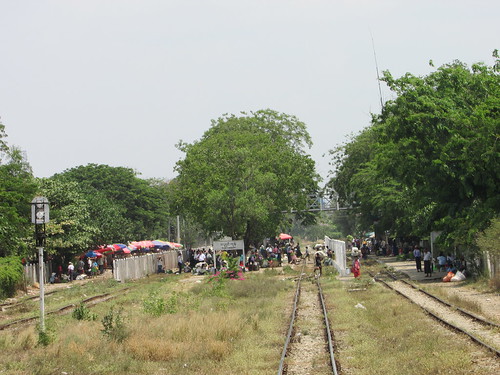 Da Nyin Gone staion, viewed from an approaching Clockwise Circle Line DMU.
Da Nyin Gone staion, viewed from an approaching Clockwise Circle Line DMU.
Origins of Da Nyn Gone Station
Rail transport was first introduced in Myanmar in May 1877, when Lower Burma was a British colony, with the opening of the 163-mile (262 km) Yangon to Pyay line which passed through Da Nyn Gone by The Irrawaddy Valley State Railway. At that time, the Yangon terminus was at Kyee Myin Daing. Da Nyn Gone became a junction when the Circle Line was constructed, diverging to the north east from Da Nyn Gone and then looping back south so as to provide a route back to Yangon.
Track Layout
Rather than providing a 'classical' double track junction incorporating a diamond crossing (as is provided at Pazundaung and Yangon Central Station), the junction between the original line to Pyay and the later Circle Line is now implemented as a trailing crossover and two facing turnouts, in accordance with more modern practice. There are two sidings, controlled from hand levers, which appear to be out of use. One is south of the platform on the Up Circle Line, the other north of the level crossing on the Down Pyay Line. All other turnouts are operated by electric point machines.
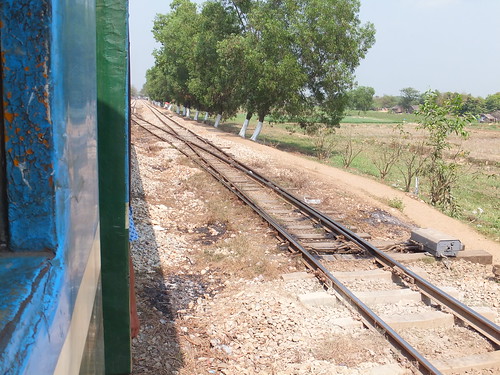 View from train approaching Da Nyn Gone station, showing electric point machine at the south end of the trailing crossover.
View from train approaching Da Nyn Gone station, showing electric point machine at the south end of the trailing crossover.
Signalling
The station area is controlled by a mixture of 2-aspect and 3-aspect colour light signals.
 In 2013, DD.931 waits for signal 4L at Da Nyn Gone with a clockwise Circle Line train. The level crossing is in the background.
In 2013, DD.931 waits for signal 4L at Da Nyn Gone with a clockwise Circle Line train. The level crossing is in the background.
Signal '9L' is a 3-aspect with a route indicator of four white inclined lights which are illuminated for movements onto the Pyay line.
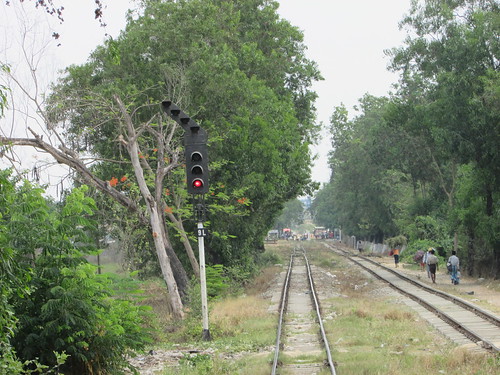 Da Nyi Gone signal '9L' displaying a 'Red'. The station is visible in the background
Da Nyi Gone signal '9L' displaying a 'Red'. The station is visible in the background
 Signalling Control Panel at Da Nyn Gone.
Signalling Control Panel at Da Nyn Gone.
Signalling Control
A small signalling control panel is situated in the station building.
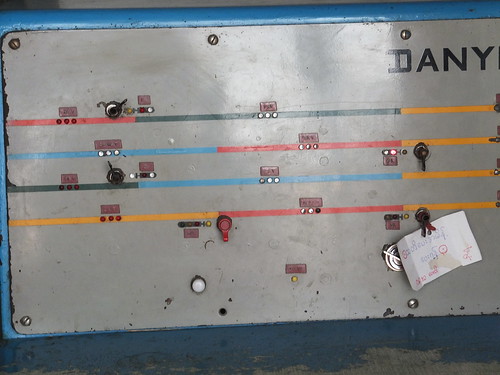 Enlarged view of left side of Signalling Control Panel at Da Nyn Gone.
Enlarged view of left side of Signalling Control Panel at Da Nyn Gone.
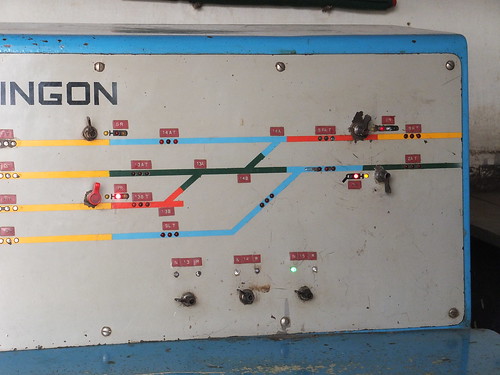 Enlarged view of right side of Signalling Control Panel at Da Nyn Gone..
Enlarged view of right side of Signalling Control Panel at Da Nyn Gone..
Background
I first saw this station in 2008 when I made a round trip on the Circle Line (described in the post The Circle Line, Yangon), but there are no pictures of Da Nyn Gone.
In 2012 I travelled on part of the Circle Line (report here) but didn't pass through Da Nyn Gone.
The following year, on 14th February 2013, I travelled from Yangon Central Station to and from the junction at Da Nyn Gone, producing pictures here and the post Yangon Area Railways.
On the 25th April 2014, I made a cab ride around the Circle line (see post Cab Ride around the Circle Line), and pictures here.
By 2015, the 'New' Diesel Multiple Units were being introduced and, on 4th May 2015, I went around the Circle line on one of these collecting more views in album The Circle Line by DMU.
Another 'New' Diesel Multiple Unit provided the motive power on 22nd April 2016 when I made another clockwise trip of the Circle Line with my young friend Aung (pictures here).
Related posts in my blog
The Circle Line, Yangon (2008).
Exploring Yangon's railways.
Railway Signalling in Burma - Part 2: Colour Light Signals & Motor Points.
Railway Signalling in Burma - Part 6: Signal Boxes with Electrical Interlocking.
Yangon Area Railways
All my Myanma Railways posts.
My Pictures
Pictures in this article are taken from the album Da Nyn Gone Railway Station
Railways in Myanmar (formerly Burma) (2008).
Yangon to Insein by Train (2016).
Cab Ride on the Circle Line (2014).
The Circle Line, Yangon (2013).
Circle Line Revisited (2012).
The Circle Line by DMU (2015).
Around the Circle Line in 2016 (2016).
The Circle Line, Yangon, Myanmar (2009).
Burma: Colour Light Signals & Motor Points.
Yangon Central Station.
Railways in Myanmar (2008).
All my Myanma Railways Pictures.
 Powered fishing boat leaving Ba Wel Island, towing small boats.
Powered fishing boat leaving Ba Wel Island, towing small boats.
 Nyaung Wee Island, Mergui Archipelago.
Nyaung Wee Island, Mergui Archipelago.
 Being conducted through the village by the young local children.
Being conducted through the village by the young local children.
 Nyaung Wee Island: At the village shop.
Nyaung Wee Island: At the village shop.
 Nyaung Wee Island: Rebuilding a house.
Nyaung Wee Island: Rebuilding a house.
 Nyaung Wee Island, Mergui Archipelago.
Nyaung Wee Island, Mergui Archipelago.
 Clara Island beach visit, with 'Meta IV' in the background.
Clara Island beach visit, with 'Meta IV' in the background.
 Clara Island beach visit: The kayak patiently awaits its next user.
Clara Island beach visit: The kayak patiently awaits its next user.














































